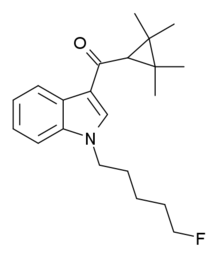XLR-11
 | |
| Legal status | |
|---|---|
| Legal status |
|
| Identifiers | |
| |
JSmol) | |
| |
| |
XLR-11 (5"-fluoro-UR-144 or 5F-UR-144) is a drug that acts as a potent
Detection
A forensic standard for this compound is available, and a representative mass spectrum has been posted on Forendex.[5]
Recreational use
XLR-11 was instead first identified by laboratories in 2012 as an ingredient in
Legal Status
XLR-11 was banned in New Zealand by being added to the temporary class drug schedule, effective from 13 July 2012.[7]
The U.S. Drug Enforcement Administration (DEA) made XLR11 illegal under the Federal Controlled Substances act for the foreseeable future as of January 2024.[8]
It has also been banned in Florida as of 11 December 2012.[9]
Arizona banned XLR-11 on 3 April 2013.[10]
As of October 2015 XLR-11 is a controlled substance in China.[11]
XLR-11 is banned in the Czech Republic.[12]
Side effects
XLR-11 has been linked to hospitalizations due to its use.[13]
Toxicity
XLR-11 has been linked to acute kidney injury in some users,[14] along with AM-2201.[15][16]
See also
References
- ^ Anvisa (24 July 2023). "RDC Nº 804 - Listas de Substâncias Entorpecentes, Psicotrópicas, Precursoras e Outras sob Controle Especial" [Collegiate Board Resolution No. 804 - Lists of Narcotic, Psychotropic, Precursor, and Other Substances under Special Control] (in Brazilian Portuguese). Diário Oficial da União (published 25 July 2023). Archived from the original on 27 August 2023. Retrieved 27 August 2023.
- ^ PMID 25921407.
- ^ WO application 2006069196, Pace JM, Tietje K, Dart MJ, Meyer MD, "3-Cycloalkylcarbonyl indoles as cannabinoid receptor ligands", published 2006-06-29, assigned to Abbott Laboratories
- PMID 19921781.
- ^ "XLR-11". Structural, chemical, and analytical data on controlled substances. Southern Association of Forensic Scientists (SAFS).
- doi:10.1071/CH14198.
- ^ "CB-13, MAM-2201, AKB48, and XLR11 are classified as temporary class drugs". Temporary Class Drug Notice. The Department of Internal Affairs: New Zealand Gazette. 5 July 2012.
- ^ DEA. https://www.deadiversion.usdoj.gov/schedules/orangebook/orangebook.pdf.
{{cite web}}: Missing or empty|title=(help) - ^ "Attorney General Pam Bondi Outlaws Additional Synthetic Drugs" (Press release). State of Florida. 11 December 2012.
- ^ "Governor Jan Brewer Signs Legislation to Combat Production, Use of Dangerous Drugs" (PDF) (Press release). Office of the Governor, State of Arizona. Archived from the original (PDF) on 7 June 2013. Retrieved 27 August 2014.
- ^ "关于印发《非药用类麻醉药品和精神药品列管办法》的通知" (in Chinese). China Food and Drug Administration. 27 September 2015. Retrieved 1 October 2015.
- ^ "Látky, o které byl doplněn seznam č. 4 psychotropních látek (příloha č. 4 k nařízení vlády č. 463/2013 Sb.)" (PDF) (in Czech). Ministerstvo zdravotnictví.
- PMID 26154784.
- ^ "Alphabet Soup, or the newer synthetic cannabinoids..." The Dose Makes The Poison Blog. 11 December 2013. Retrieved 18 September 2014.
- PMID 23243266.
- ^ "Acute Kidney Injury Associated with Synthetic Cannabinoid Use – Multiple States, 2012". Morbidity and Mortality Weekly Report. U.S. Centers for Disease Control and Prevention (CDC). 15 February 2013. Retrieved 15 February 2013.
